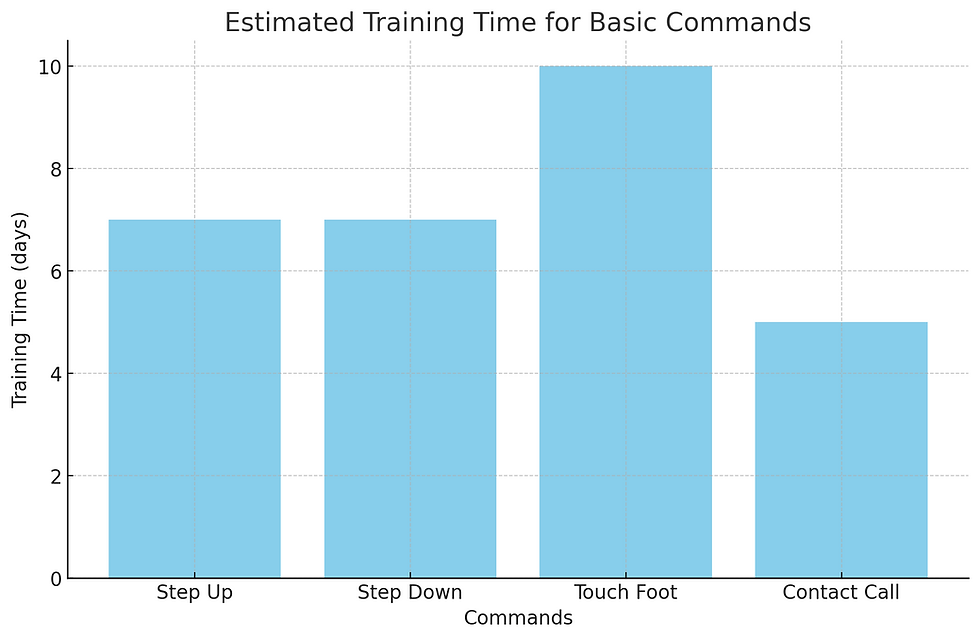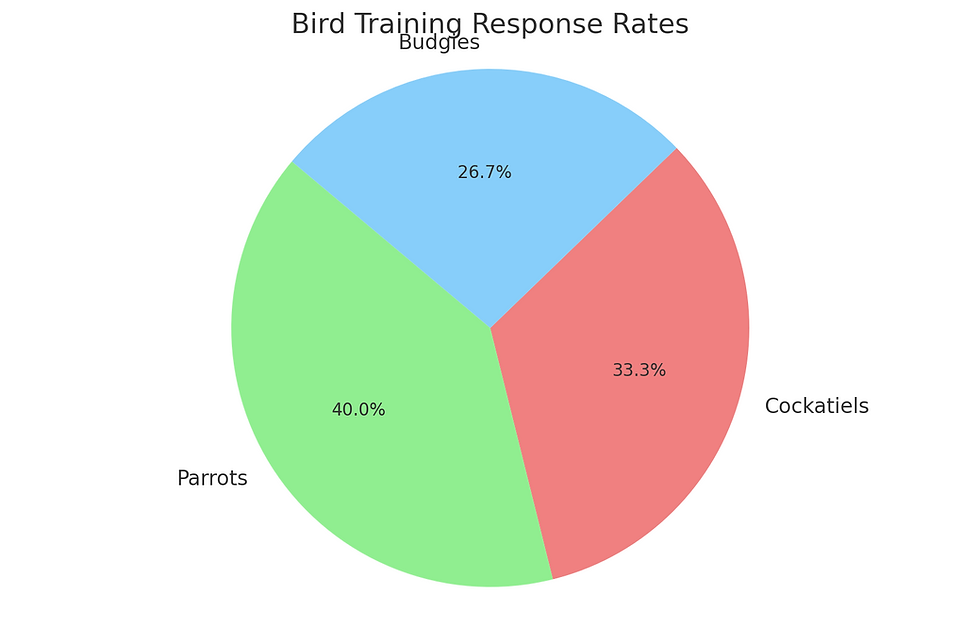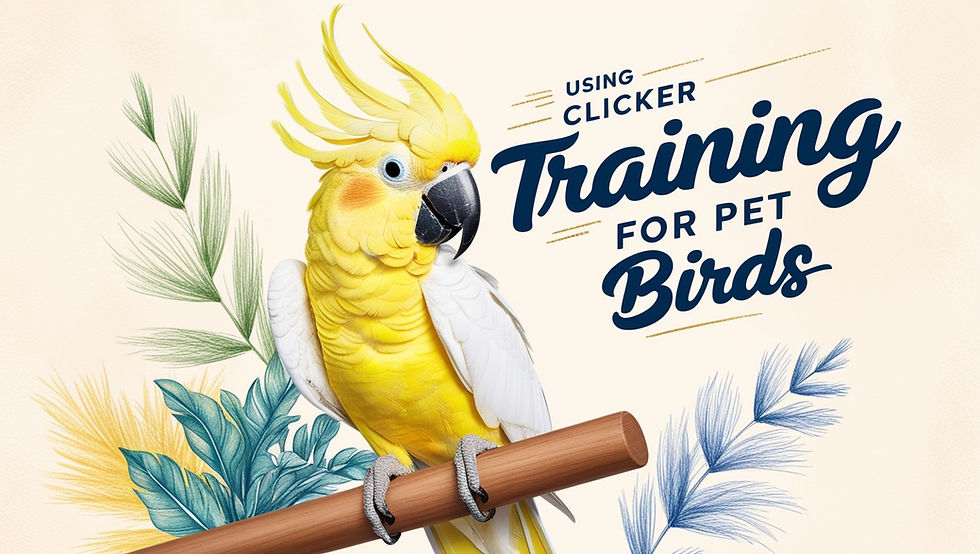Teaching Basic Commands to Birds
- Saifur Rahman
- Jun 28, 2024
- 8 min read
Key Takeaways Table
Command | Purpose | Steps for Training |
Step Up | Encourages bird to step onto your hand | Use treats and verbal praise; practice daily |
Step Down | Guides bird back to cage or perch | Similar to Step Up, but with different treats |
Touch Foot | Prepares bird for nail trimming | Gradual process using treats and positive reinforcement |
Contact Call | Reduces screaming by maintaining contact | Consistent use of a specific call or whistle |

Introduction
Teaching basic commands to your pet bird is a rewarding process that enhances your bond and ensures better care and safety for your feathered friend.
Commands like "Step Up," "Step Down," "Touch Foot," and "Contact Call" are fundamental for effective communication and care. This guide will walk you through the steps to teach these essential commands.
Step Up
The "Step Up" command is one of the first and most important commands to teach your bird. This command encourages your bird to step onto your hand, making it easier to interact and handle your bird safely.
Training Steps:
Approach Gently: Slowly offer your hand or finger to your bird’s belly and say, "Step up."
Reward Immediately: When your bird steps onto your hand, reward it with a treat and verbal praise.
Repeat Consistently: Practice this command daily for short periods to reinforce the behavior.
Tips for Success:
Use a calm and consistent tone when giving the command.
Ensure your bird is comfortable and not stressed before starting the training session.
Be patient; it may take several days or weeks for your bird to reliably respond to the command.
For more detailed training techniques, you can explore our Bird Training Tips.
Step Down
The "Step Down" command is essential for guiding your bird back to its cage or a designated perch.
This command ensures that your bird knows when and where to go when it’s time to rest or when you need to end playtime.
Training Steps:
Approach the Perch: Bring your bird close to the perch or cage and say, "Step down."
Encourage the Step: Gently encourage your bird to step onto the perch.
Reward and Praise: Immediately reward your bird with a treat and verbal praise once it steps down.
Tips for Success:
Use a different treat than the one used for "Step Up" to avoid confusion.
Practice this command consistently to ensure your bird becomes familiar with the action.
Optimizing your bird’s environment for training can be explored further in our guide on Bird Cage Setup.
Touch Foot
Teaching your bird to tolerate having its feet touched is crucial for regular nail trimming and health checks.
The "Touch Foot" command helps desensitize your bird to this necessary handling.
Training Steps:
Introduce Touching: Start by gently touching your bird’s foot and saying, "Touch foot."
Reward Gradually: Initially, reward any calm behavior with a treat.
Increase Duration: Gradually increase the duration of the touch before giving the treat.
Tips for Success:
Use a calm and reassuring tone to avoid startling your bird.
Practice this command in short, regular sessions to build your bird’s comfort with foot handling.
Understanding the importance of regular nail care is covered in our article on Common Bird Diseases.
Contact Call
A contact call is a specific sound or word used to reassure your bird of your presence, reducing anxiety and unwanted screaming.
Establishing a contact call helps maintain a connection with your bird even when you are not in the same room.
Training Steps:
Choose a Call: Decide on a unique whistle or phrase.
Use Consistently: Use the call consistently whenever you enter or leave a room.
Respond Promptly: Always respond to your bird’s contact call but ignore any screaming to avoid reinforcing negative behavior.
Tips for Success:
Choose a simple and unique call that your bird can easily recognize.
Ensure all family members use the same call to maintain consistency.
For a well-rounded approach to bird care, check out our resources on Bird Nutrition.
Setting Up a Positive Training Environment
Creating a conducive training environment is key to successful bird training.
Dedicated Space: Set up a specific area for training where your bird feels safe and unthreatened.
Positive Reinforcement: Use treats, verbal praise, and gentle petting to reward your bird for good behavior.
Consistency: Practice commands regularly in short, engaging sessions to keep your bird’s attention.
For species-specific training tips, refer to our Bird Species Profiles.

Additional Training Tips and Resources
Training your bird goes beyond just the basic commands. It's important to continue enriching your bird's environment and expanding its skills.
Here are some additional tips and resources to enhance your bird's training experience.
Advanced Commands and Tricks
Once your bird has mastered the basic commands, you can introduce more advanced tricks and commands to keep its mind engaged and strengthen your bond.
Wave Command: Teach your bird to wave by lifting one foot. This can be a fun trick that builds on the "Step Up" command.
Spin Command: Encourage your bird to spin around on the perch. Use a treat to guide its movement and reinforce the action with verbal praise.
Fetch Command: Some birds enjoy fetching small objects. Use a favorite toy and reward your bird when it brings it back to you.
Creating a Stimulating Environment
A stimulating environment is crucial for your bird’s mental and physical well-being. Here are some tips to ensure your bird stays happy and healthy.
Toys and Enrichment: Provide a variety of toys that challenge your bird's problem-solving skills and keep it entertained.
Foraging Activities: Hide treats in different parts of the cage to encourage your bird to forage and explore.
Social Interaction: Spend quality time with your bird daily. Birds are social creatures and thrive on interaction with their human companions.
For more ideas on enriching your bird’s environment, check out our section on Bird Toys and Enrichment.
Understanding Bird Behavior
Understanding your bird's behavior is key to successful training. Recognizing signs of stress, happiness, and curiosity can help you tailor your training sessions to your bird's needs.
Body Language: Learn to read your bird's body language. Fluffed feathers, tail bobbing, and beak grinding can indicate different emotional states.
Vocalizations: Pay attention to your bird's sounds. Different chirps, squawks, and calls can convey a range of messages.
Routine and Consistency: Birds thrive on routine. Keep training sessions consistent in time and place to help your bird feel secure and confident.
For more on bird behavior, explore our detailed guide on Bird Behavior.
Health and Nutrition
A healthy bird is a happy bird. Proper nutrition and regular health checks are vital components of bird care.
Balanced Diet: Ensure your bird receives a balanced diet that includes seeds, pellets, fresh fruits, and vegetables.
Regular Check-ups: Schedule regular check-ups with an avian vet to monitor your bird's health and address any issues early.
Hydration: Always provide fresh water and monitor your bird's drinking habits to prevent dehydration.
For more on maintaining your bird's health, visit our page on the Importance of a Balanced Diet for Birds.
Troubleshooting Common Training Challenges
Training birds can sometimes present challenges. Here are some common issues you might encounter and tips on how to address them.
Bird is Reluctant to Step Up
If your bird is hesitant to step up onto your hand, it might be due to fear or lack of trust.
Solution:
Build Trust: Spend time near your bird's cage, talking softly and offering treats through the bars to build trust.
Use a Perch: Start by using a handheld perch instead of your hand. Gradually transition to your hand as your bird becomes more comfortable.
Patience and Consistency: Be patient and consistent with your training. Don’t force your bird to step up if it seems scared.
For more detailed advice on building trust, explore our guide on Socializing Pet Birds.
Bird Bites During Training
Birds may bite if they feel threatened, scared, or simply curious. Understanding the reason behind the biting can help you address it effectively.
Solution:
Avoid Negative Reactions: Do not react aggressively or shout when your bird bites. This can reinforce the behavior.
Positive Reinforcement: Use positive reinforcement to encourage gentle behavior. Reward your bird when it interacts without biting.
Identify Triggers: Pay attention to what might be triggering the biting and try to eliminate or reduce these triggers.
Learn more about addressing biting and other behavior issues in our section on Bird Behavior.
Bird Screams Excessively
Excessive screaming can be a sign of boredom, lack of stimulation, or a way for your bird to get attention.
Solution:
Ignore Negative Behavior: Do not respond to screaming, as this can reinforce the behavior. Only respond when your bird is quiet.
Provide Enrichment: Ensure your bird has plenty of toys and activities to stay entertained.
Routine and Structure: Establish a daily routine that includes time for play, training, and social interaction.
For more tips on managing screaming and other vocalizations, visit our guide on Bird Behavior.

Frequently Asked Questions
What treats should I use for training my bird?
Use small, healthy treats that your bird loves and only gets during training sessions. Popular options include small pieces of fruit, nuts, or specially formulated bird treats.
How long should each training session be?
Keep training sessions short, around 5-10 minutes, to hold your bird's attention and prevent fatigue. Multiple short sessions throughout the day are more effective than one long session.
Can all bird species be trained?
While most bird species can be trained, some are more responsive than others. Parrots, for example, are highly intelligent and typically respond well to training. Adjust your training methods based on your bird’s species and individual personality. For more on training different bird species, explore our Bird Species Profiles.
Keeping the Training Fun and Engaging
Maintaining your bird's interest in training sessions is crucial for successful learning. Here are some strategies to keep training fun and engaging for both you and your bird.
Varying the Training Routine
Mix Up Commands: Avoid repetitive training sessions by mixing up the commands you are working on. This keeps your bird engaged and prevents boredom.
Introduce New Tricks: Once your bird has mastered basic commands, introduce new tricks to keep the training challenging and exciting.
Short and Sweet Sessions: Keep training sessions short, around 5-10 minutes, to maintain your bird's attention and prevent fatigue. For more advanced tricks and tips, visit our Bird Training Tips.
Using Interactive Toys
Interactive toys can be a great addition to your bird's training regimen. These toys not only provide mental stimulation but also reinforce training concepts.
Puzzle Toys: Use puzzle toys that require your bird to figure out how to get a treat. This encourages problem-solving skills.
Foraging Toys: Hide treats in foraging toys to stimulate natural foraging behavior and keep your bird entertained.
Training Aids: Utilize training aids like clickers to mark desired behaviors, making it easier for your bird to understand what is being rewarded. Check out our recommendations for Bird Toys and Enrichment.
Incorporating Social Interaction
Birds are social animals and thrive on interaction with their human companions. Incorporating social interaction into training can make the experience more enjoyable for your bird.
Talk to Your Bird: Use a soothing and encouraging tone while training. Talking to your bird helps build trust and reinforces positive behavior.
Involve Family Members: Encourage other family members to participate in the training sessions. This helps your bird become comfortable with different people.
Training Playdates: If possible, arrange playdates with other birds. Socializing with other birds can provide additional mental stimulation and learning opportunities. Learn more about Socializing Pet Birds.
Monitoring Progress and Adjusting Techniques
Keeping track of your bird's progress is important to ensure effective training. Here are some tips for monitoring progress and adjusting techniques as needed.
Record Sessions: Keep a training journal to record what commands were practiced, how your bird responded, and any improvements or challenges.
Adjust Rewards: If your bird loses interest in a particular treat, switch it up with something new to maintain motivation.
Be Flexible: Adjust your training techniques based on your bird's responses. If a particular method isn’t working, try a different approach. For tips on adjusting training techniques, refer to our Bird Behavior section.

Training Success Stories
Reading about other bird owners' training success stories can be inspiring and provide useful tips for your own training journey. Here are a few success stories from our community:
Parrot's First Words: A parrot owner shares how their bird learned to say its first words using positive reinforcement and daily practice.
Overcoming Fear: A cockatiel owner describes how they helped their bird overcome its fear of hands through gradual desensitization and trust-building exercises.
Learning Tricks: A budgie owner highlights how they taught their bird to perform various tricks, from spinning to playing fetch, using interactive toys and consistent training. Share your own success story or read more in our Bird Owner Community.
Final Thoughts
Training your bird is a rewarding journey that strengthens your bond and enhances your bird’s well-being. By teaching basic commands, incorporating advanced tricks, and creating a stimulating environment, you can ensure a happy and healthy life for your feathered friend.
Continue exploring our resources and articles to support your bird training journey:

Comments